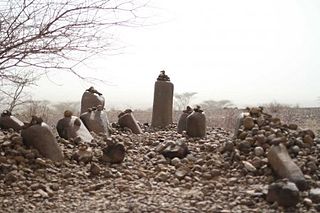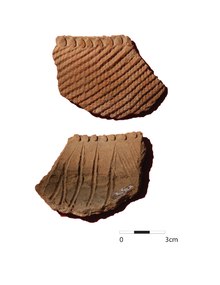
Ceramics of Indigenous peoples of the Americas is an art form with at least a 7500-year history in the Americas. Pottery is fired ceramics with clay as a component. Ceramics are used for utilitarian cooking vessels, serving and storage vessels, pipes, funerary urns, censers, musical instruments, ceremonial items, masks, toys, sculptures, and a myriad of other art forms.

Meave G. Leakey is a British palaeoanthropologist. She works at Stony Brook University and is co-ordinator of Plio-Pleistocene research at the Turkana Basin Institute. She studies early hominid evolution and has done extensive field research in the Turkana Basin. She has Doctor of Philosophy and Doctor of Science degrees.
Hyrax Hill is a prehistoric site near Nakuru in the Rift Valley province of Kenya. It is a rocky spur roughly half a kilometer in length, with an elevation of 1,900 meters above sea level at its summit. The site was first discovered in 1926 by Louis Leakey during excavations at the nearby Nakuru Burial Site, and Mary Leakey conducted the first major excavations between 1937 and 1938. There are two distinct areas of occupation at Hyrax Hill: one which was occupied during the Pastoral Neolithic and late Iron Age, and one which was occupied by the Sirikwa earlier in the Iron Age.
Yuchanyan is an early Neolithic cave site in Dao County (Daoxian), Hunan, China. The site yielded sherds of ceramic vessels and other artifacts which were dated by analysis of charcoal and bone collagen, giving a date range of 17,500 to 18,300 years old for the pottery. The pottery specimens may be the oldest known examples of pottery.

Lothagam is a geological formation located in Kenya, near the southwestern shores of Lake Turkana, 55 km (34 mi) from Kanapoi. It is located between the Kerio and Lomunyenkuparet Rivers on an uplifted fault block.

The Nasura Pillar Site, registered as GcJh3 and also known as Namoratunga II, is an archaeological site on the west side of Lake Turkana in Kenya dating to the Pastoral Neolithic. Namoratunga means "people of stone" in the Turkana language. The site was originally believed to have been created around 300 BC, but recent excavations have yielded an older radiocarbon sample dating to 2398 +/- 44 years BC.
Lokori is a Turkana settlement in Kenya's North Eastern Province, adjacent to the Kerio River. The settlement's inhabitants are traditionally pastoralists. Lokori is home to a number of prehistoric Namoratunga rock art and burial sites.

The greater Turkana Basin in East Africa determines a large endorheic basin, a drainage basin with no outflow centered around the north-southwards directed Gregory Rift system in Kenya and southern Ethiopia. The deepest point of the basin is the endorheic Lake Turkana, a brackish soda lake with a very high ecological productivity in the Gregory Rift.

The Pastoral Neolithic refers to a period in Africa's prehistory, specifically Tanzania and Kenya, marking the beginning of food production, livestock domestication, and pottery use in the region following the Later Stone Age. The exact dates of this time period remain inexact, but early Pastoral Neolithic sites support the beginning of herding by 5000 BP. In contrast to the Neolithic in other parts of the world, which saw the development of farming societies, the first form of African food production was nomadic pastoralism, or ways of life centered on the herding and management of livestock. The shift from hunting to food production relied on livestock that had been domesticated outside of East Africa, especially North Africa. This period marks the emergence of the forms of pastoralism that are still present. The reliance on livestock herding marks the deviation from hunting-gathering but precedes major agricultural development. The exact movement tendencies of Neolithic pastoralists are not completely understood.

Kanapoi is a paleontological site in the Kenyan Rift Valley, to the southwest of Lake Turkana. Fossils were first found at Kanapoi in the 1960s by a Harvard expedition, and later by expeditions from the National Museums of Kenya.
Kansyore pottery is a type of ancient East African pottery.

Aiyangiyang is a basin in southern Turkana, Kenya, southeast of Lodwar. It is known by nomadic pastoralists for its seasonal water availability, and is an important archaeological and paleontological site with artifacts and remains from the African Middle and Late Stone Ages.
Njoro River Cave is an archaeological site on the Mau Escarpment, Kenya, that was first excavated in 1938 by Mary Leakey and her husband Louis Leakey. Excavations revealed a mass cremation site created by Elmenteitan pastoralists during the Pastoral Neolithic roughly 3350-3050 BP. Excavations also uncovered pottery, beads, stone bowls, basket work, pestles and flakes. The Leakeys' excavation was one of the earliest to uncover ancient beads and tools in the area and a later investigation in 1950 was the first to use radiocarbon dating in East Africa.
Bir Kiseiba is a Neolithic archaeological site in Egypt, dating from approximately 11,000–5,000 BP, that lies approximately 250 km west of the Nile in Lower Nubia. Excavated by Fred Wendorf, Romauld Schild, and Angela Close, Bir Kiseiba, along with Nabta Playa, has some of the earliest evidence for food production, permanent settlement, and more diverse technologies as compared to sites from the Late Pleistocene. Wendorf and associates argue that cattle and pottery were here as early as any other place in Africa, although this assertion has been challenged.

The Elmenteitan culture was a prehistoric lithic industry and pottery tradition with a distinct pattern of land use, hunting and pastoralism that appeared and developed on the western plains of Kenya, East Africa during the Pastoral Neolithic c.3300-1200 BP. It was named by archaeologist Louis Leakey after Lake Elmenteita, a soda lake located in the Great Rift Valley, about 120 km (75 mi) northwest of Nairobi.

Philippine ceramics refers to ceramic art and pottery designed or produced as a form of Philippine art.

The Lothagam North Pillar Site, registered as GeJi9, is an archaeological site at Lothagam on the west side of Lake Turkana in Kenya dating to the Pastoral Neolithic and the Holocene. It is a communal cemetery, built between 3000 BCE and 2300 BCE by the region's earliest herders as rainfall in the area decreased and Lake Turkana receded. It is thought to be eastern Africa's largest and earliest monumental cemetery.
In archaeology, Organic Residue Analysis (ORA) refers to the study of micro-remains trapped in or adhered to artifacts from the past. These organic residues can include lipids, proteins, starches, and sugars. By analyzing these residues, ORA can reveal insights into ancient dietary behaviors, agricultural practices, housing organization, technological advancements, and trade interactions. Furthermore, it provides information on the use of cosmetics, arts, crafts, medicine, and burial preparations in ancient societies.
The Jarigole pillar site is one of the megalithic communal cemetery sites in Lake Turkana Basin in Northern Kenya associated with the Pastoral Neolithic period. The site is located on the eastern shores of Lake Turkana in the southeastern edge of the Sibiloi National Park. Situated in a recessional beach which is 70 m (230 ft) above the 1973 lake level, the site includes oval platforms >1,000 m2 (11,000 sq ft) with a circular mound, and 28 basalt pillars each weighing about 200 kg (440 lb) and moved over a distance of 2 km (1.2 mi) from the site. The site is believed to have been constructed by the first wave of ancient herders who migrated to the region down from the Sahara around 5,000 years ago, a period marked by rapid climatic, economic and social change.
Manemanya (GcJh5) is an archaeological site within the Lake Turkana basin in northern Kenya. It is a communal burial site built almost 5,000 years ago and is associated with the advent of pastoralism in eastern Africa during the Pastoral Neolithic period. Manemanya is located 1 km east of Lesodok hill, on the western shores of Lake Turkana. Comprising nine pillar clusters situated across two distinct zones, this site lacks evident platform mounds or cairns. However, its distinctiveness is marked by the presence of cobbles in the central area, a distinguishing feature that sets it apart from the natural surface surrounding the site, presenting a notable contrast with other pillar sites in the Lake Turkana basin.











